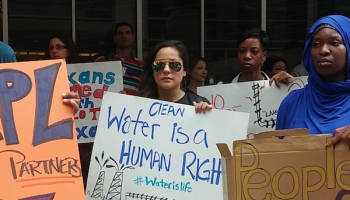PFAS are everywhere, yet the vast majority of uses are not necessary. As explained in our 2022 report, children’s car seat makers sometimes use fabric treated with PFAS (per- and polyfluoroalkyl substances) to repel water and stains. We tested the fabric from 19 infant and convertible seats, and from four strollers that were bundled with car seats, for total organic fluorine. We used the results to determine that four of the car seats and two of the matching strollers likely contained PFAS. For more on this method, please see the report.
Recently, our partners at Toxic-Free Future found 72% of home furnishing products labeled stain- or water-resistant contained PFAS. (Read their report here.)
If you're not familiar with PFAS, check out our fact sheet.
We also developed a quick home test to see if your products may be treated with PFAS.
PFAS treatments cause a fabric to strongly repel water. If you drop a water droplet onto a PFAS-treated fabric, it will bead up, roll around, and typically leaves no residue. In contrast, a droplet dropped onto an untreated fabric will soak in.
A “positive” water drop result does not definitely indicate PFAS. Non-PFAS alternatives exist. For example, a Clek car seat tested by the Healthy Stuff Lab showed a “positive” result with the droplet beading up and rolling because the “C-zero” fabric on the seat contains a proprietary non-PFAS treatment. Another alternative is wool and wool-blend fabrics, which are naturally water-repellent to varying degrees.
What to do
If you suspect your product has PFAS, contact the manufacturer to ask. Ask them to remove PFAS from all of their products. Non-PFAS alternative treatments are available. Using PFAS is not worth contaminating drinking water around the world.
You can also avoid buying apparel and home furnishings that advertise stain or water resistance. Testing has confirmed that many items marketed as stain-resistant, from clothing to bedding, tablecloths, and napkins, are treated with PFAS. Instead, choose washable items.
To learn more about our work on PFAS in products, check out Still Cooking: An Update on Toxic PFAS in Cookware Products.


